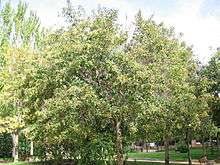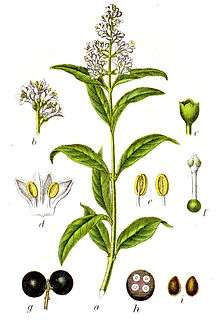Ligustrum japonicum
Ligustrum japonicum, known as wax-leaf privet[1] or Japanese privet (Japanese: ネズミモチ) is a species of Ligustrum (privet) native to central and southern Japan (Honshū, Shikoku, Kyūshū, Okinawa) and Korea.[2] It is widely cultivated in other regions, and is naturalized in California and in the southeastern United States from Texas to Virginia.[3]
| Ligustrum japonicum | |
|---|---|
 | |
 | |
| Figure from Sturm 1796 Deutschlands Flora in Abbildungen | |
| Scientific classification | |
| Kingdom: | Plantae |
| Clade: | Tracheophytes |
| Clade: | Angiosperms |
| Clade: | Eudicots |
| Clade: | Asterids |
| Order: | Lamiales |
| Family: | Oleaceae |
| Genus: | Ligustrum |
| Species: | L. japonicum |
| Binomial name | |
| Ligustrum japonicum | |
It is an evergreen shrub or small tree growing to 2–5 m (rarely 6 m) tall, with smooth, pale grey-brown bark on the stems. The leaves are opposite, 5–10 cm long and 2–5 cm broad, glossy dark green above, paler glaucous to yellowish green below, thick and leathery textured, and with an entire margin. The flowers are white, with a four-lobed corolla 5–6 mm long; they are borne in clusters 7–15 cm long in early summer.[4] The fruit is an oval drupe, 10 mm long, ripening purple-black with a glaucous waxy bloom in early winter; in Japan they are popularly likened to mouse or rat droppings. The species is closely related to the Chinese Ligustrum lucidum, differing in its smaller size (L. lucidum making a tree to over 10 m tall), and elongated oval (not subglobose) fruit.[5][6][7][8][9]
Cultivation and uses
The fruit is used in herbal medicine as a cardiotonic, diuretic, laxative and tonic treatment.[8]
The plant arrived in North America in the early 1800s and has become an invasive plant, particularly in the American South.[10] It is occasionally grown as an ornamental plant in Europe and North America; a number of cultivars have been selected for garden use, including "Rotundifolium" with leaves nearly as broad as long, and "Silver Star" with creamy-white margins to the leaves.[11]
Gallery
 flowers
flowers Immature fruit
Immature fruit
References
- English Names for Korean Native Plants (PDF). Pocheon: Korea National Arboretum. 2015. p. 518. ISBN 978-89-97450-98-5. Archived from the original (PDF) on 25 May 2017. Retrieved 4 January 2017 – via Korea Forest Service.
- Kew World Checklist of Selected Plant Families, Ligustrum japonicum
- Biota of North America Program, Ligustrum japonicum
- John R. Seiler, Edward C. Jensen, or John A. Peterson. "Japanese Privet". vTree. Virginia Tech Department of Forest Resources and Environmental Conservation. Archived from the original on 2013-10-25.CS1 maint: uses authors parameter (link)
- Hata Plant Ecology Laboratory: Ligustrum japonicum (in Japanese; google translation)
- Rokko Mountain guide to trees: Ligustrum japonicum (in Japanese; google translation)
- Kizzu Guide: Ligustrum japonicum Archived 2006-10-14 at the Wayback Machine (in Japanese; google translation)
- Yakusou medicinal plants: Ligustrum japonicum (in Japanese; google translation)
- Flavon's Wild herb and Alpine plants: Ligustrum japonicum
- "Japanese privet". Invasive Plant Atlas. July 15, 2013. Retrieved February 22, 2014.
- Huxley, A., ed. (1992). New RHS Dictionary of Gardening. Macmillan ISBN 0-333-47494-5.
- Gledhill, David (2008). "The Names of Plants". Cambridge University Press. ISBN 9780521866453 (hardback), ISBN 9780521685535 (paperback). p 237
| Wikimedia Commons has media related to Ligustrum japonicum. |
| Wikispecies has information related to Ligustrum japonicum |